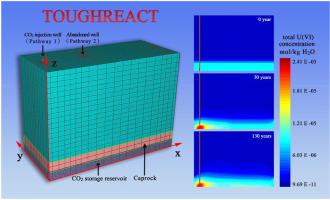当前位置:
X-MOL 学术
›
Appl. Geochem.
›
论文详情
Our official English website, www.x-mol.net, welcomes your
feedback! (Note: you will need to create a separate account there.)
Simulation of uranium mobilization potential in a deep aquifer under geological carbon storage conditions
Applied Geochemistry ( IF 3.1 ) Pub Date : 2020-07-01 , DOI: 10.1016/j.apgeochem.2020.104620 Qihuang Wang , Xiuxiu Miao , Yan Wang , Manguang Gan , Syed Mobashar Aftab , Xiaochun Li , Liwei Zhang , Zimeng Wang
Applied Geochemistry ( IF 3.1 ) Pub Date : 2020-07-01 , DOI: 10.1016/j.apgeochem.2020.104620 Qihuang Wang , Xiuxiu Miao , Yan Wang , Manguang Gan , Syed Mobashar Aftab , Xiaochun Li , Liwei Zhang , Zimeng Wang

|
Abstract Geological carbon storage is considered as a promising strategy to reduce greenhouse gas emissions. For those subsurface systems with uranium-bearing minerals in rock formations, there is an uncharacterized possibility for injected CO2 to cause uranium mobilization due to the coupled chemical and physical interactions at mineral--water interfaces. We developed a TOUGHREACT model to assess the uranium mobilization potential from uraninite (UO2) dissolution induced by CO2 injection into a hypothetical CO2 storage reservoir in a time scale of 30 years of CO2 injection and 100 years after. Numerical simulation results show that the concentration of HCO3− increased after CO2 injection, and CO2 was able to migrate toward the shallow aquifer through existing leakage pathways. HCO3−-assisted UO2 oxidative dissolution was the dominant mechanism that led to the increase of dissolved uranium concentration in a form of uranyl carbonate complex and the mechanism of H+-assisted UO2 dissolution could be ignored. Sensitivity tests suggested that the increase of UO2 content and O2 level in the CO2 storage reservoir resulted in the most significant increase of dissolved uranium concentration, but no sign of uranium intrusion was predicted up to the shallow aquifer. In summary, uranium release induced by CO2 injection is possible if the target CO2 storage reservoir contains U-bearing minerals and is exposed to oxidizing environment, but our simulation assured that significant upward migration of uranium from deep CO2 storage reservoir driven by CO2 injection is unlikely even at the worst scenario.
中文翻译:

地质碳储存条件下深含水层中铀动员潜力的模拟
摘要 地质储碳被认为是一种有前景的减少温室气体排放的策略。对于那些在岩层中含有含铀矿物的地下系统,由于矿物 - 水界面上的化学和物理相互作用,注入的 CO2 有可能导致铀迁移,这是一种未知的可能性。我们开发了一个 TOUGHREACT 模型,以评估在注入 CO2 的 30 年和 100 年后的时间尺度内,将 CO2 注入假设的 CO2 储存油藏引起的铀矿 (UO2) 溶解引起的铀动员潜力。数值模拟结果表明,注入 CO2 后 HCO3− 的浓度增加,并且 CO2 能够通过现有的泄漏路径向浅层含水层迁移。HCO3-辅助的UO2氧化溶解是导致以碳酸铀酰络合物形式存在的溶解铀浓度增加的主要机制,H+辅助的UO2溶解机制可以忽略不计。敏感性测试表明,CO2 储存库中 UO2 含量和 O2 水平的增加导致溶解铀浓度的最显着增加,但预测到浅层含水层没有铀侵入的迹象。总之,如果目标 CO2 储存库包含含 U 的矿物并暴露于氧化环境,则 CO2 注入引起的铀释放是可能的,但我们的模拟确保铀从 CO2 注入驱动的深层 CO2 储存库显着向上迁移是不可能的即使在最坏的情况下。
更新日期:2020-07-01
中文翻译:

地质碳储存条件下深含水层中铀动员潜力的模拟
摘要 地质储碳被认为是一种有前景的减少温室气体排放的策略。对于那些在岩层中含有含铀矿物的地下系统,由于矿物 - 水界面上的化学和物理相互作用,注入的 CO2 有可能导致铀迁移,这是一种未知的可能性。我们开发了一个 TOUGHREACT 模型,以评估在注入 CO2 的 30 年和 100 年后的时间尺度内,将 CO2 注入假设的 CO2 储存油藏引起的铀矿 (UO2) 溶解引起的铀动员潜力。数值模拟结果表明,注入 CO2 后 HCO3− 的浓度增加,并且 CO2 能够通过现有的泄漏路径向浅层含水层迁移。HCO3-辅助的UO2氧化溶解是导致以碳酸铀酰络合物形式存在的溶解铀浓度增加的主要机制,H+辅助的UO2溶解机制可以忽略不计。敏感性测试表明,CO2 储存库中 UO2 含量和 O2 水平的增加导致溶解铀浓度的最显着增加,但预测到浅层含水层没有铀侵入的迹象。总之,如果目标 CO2 储存库包含含 U 的矿物并暴露于氧化环境,则 CO2 注入引起的铀释放是可能的,但我们的模拟确保铀从 CO2 注入驱动的深层 CO2 储存库显着向上迁移是不可能的即使在最坏的情况下。











































 京公网安备 11010802027423号
京公网安备 11010802027423号